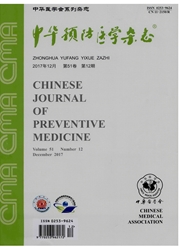

 中文摘要:
中文摘要:
目的研究母乳喂养婴儿从4月龄开始进行为期2个月的预防性铁补充对其铁营养状况的影响。方法将123名4月龄母乳喂养的婴儿按照简单随机化方法分为补铁组(63名:、对照组(60名),补铁组进行为期2个月的小剂量补铁(每天1mg/kg),对照组不予干预,采集6月龄时静脉血测定C反应蛋白和各项铁营养状况指标,并定期监测其生长发育指标,比较6月龄男婴和:女婴各项铁营养状况指标水平。结果2个月的小剂量预防性补铁实验后,补铁组和对照组分别有26、34名婴儿完成随访,补铁组婴儿血红蛋白:营长的中位数(95%C1值)为5.5(-7.0~13.0)g/L,对照组为0.0(-9.0—15.0)g/L,补铁组血红蛋白增长高于对照组(u=-2.326,P〈0.05);而两组婴儿其他铁营养状况指标及其体重、身长增长差异均无统计学意义(P值均〉0.05)。6月龄时男婴和女婴平均红细胞体积分别为(75.89±3.34)、(77.20±3.17)n(t=4.73,P〈0.05),而其他铁营养状况指标性别差异均无统计学意义(P值均〉0.05)。结论4月龄婴儿小剂量预防性补充铁剂可增加其6月龄时血红蛋白水平,且对生长发育无明显影响。
 英文摘要:
英文摘要:
Objective To analyze the effects to iron status who were given preventive iron supplements for two months from when they were breast-fed to four-month-old. Methods A total of 123 infants in four-month-old age who were breast-fed were randomly divided into iron supplementation group (63 eases) and control group (60 cases), iron supplementation group was supplied with low-dos,e iron ( 1 mg . kg-1 . d -1 ) for two months with no intervention for control group. Blood sample.s were collected to test C reactive protein and iron status indicators in six-month-old age group infants, and the growth indices were measured and compared on the gender difference of iron status at 6 months. Results After 2 months of low-dose iron supplementation, the hemoglobin of iron supplementation group (26 cases) increased about 5.5 g/L while the control group(34 cases) increased about 0. 0 g/L(median) ,95% confidence intervals were -7.0 - 13.0 g/L and -9.0 - 15.0 g/L, respectively. The hemoglobin increase of iron supplementation group was higher than the control group, the difference was statistically significant (u = -2. 326, P 〈 0. 05). The other iron nutritional status and the growth did not show any significant difference between iron supplementation group and control group ( all P values 〉 0. 05 ). At age 6 months, the MCV of the boys were ( 75.89 ±3.34 ) fl, while the girls were ( 77.20 ± 3.17 ) fl. The boys had lower values of MCV than the girls, and the gender difference was statistically significant ( t = 4. 73, P 〈 0. 05 ). The other iron nutritional status did not show any significant gender difference ( all P values 〉 0.05 ) . Conclusion Low-dose iron supplementation of breast-fed infants at 4-month-old could increase the hemoglobin level when they were 6-month-old, and had no measurable side effect on growth.
 同期刊论文项目
同期刊论文项目
 同项目期刊论文
同项目期刊论文
 期刊信息
期刊信息
